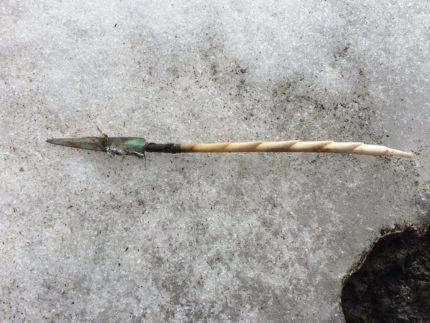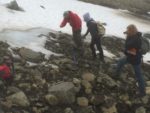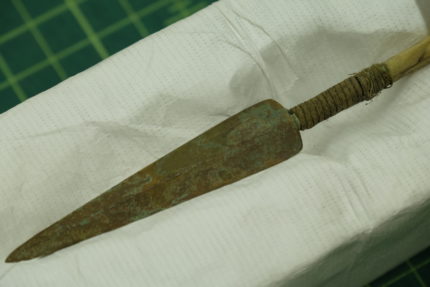A wicked looking copper arrowhead still masterfully attached to a barbed antler shaft discovered in a melting patch of ice in Yukon, Canada’s northwestern most province, in 2016 has been found to be almost 1,000 years old making it one of the earliest copper artifacts ever found in the Territory.

The credit for this discovery goes to a herd of caribou, because even though the arrowhead was found by an archaeologist, he wasn’t at the site to excavate or search for ancient artifacts. Archeologist Greg Hare was flying over the area in a helicopter accompanied by a film crew that was shooting a documentary. He was pointing out some of the sites where he and his colleagues have discovered First Nations hunting weapons when they saw the caribou. The documentarians wanted to get a clean shot of the majestic ruminants so Hare’s helicopter landed to allow the filmmakers in the second copter to get a clean shot.
 The rocky hillside where they landed was topped with a rapidly vanishing layer of half-melted ice and under normal circumstances they would never have stopped there given the precariousness of the melting ice on the surface. While they were waiting, the team spotted a barb sticking out of a barely-there thin layer of ice. They pulled it out gingerly and found a copper blade attached to the barb.
The rocky hillside where they landed was topped with a rapidly vanishing layer of half-melted ice and under normal circumstances they would never have stopped there given the precariousness of the melting ice on the surface. While they were waiting, the team spotted a barb sticking out of a barely-there thin layer of ice. They pulled it out gingerly and found a copper blade attached to the barb.
“This is one of the oldest copper elements that we ever found in the Yukon,” Hare said.
For thousands of years, caribou took refuge in the summer up high on the alpine ice patches to escape the heat and swarms of harassing insects. That made those ice patches good areas for ancient hunters to get close to the caribou.
Some weapons would miss their marks and disappear in the snow and ice, over time building a treasure trove of artifacts now revealed by the melting ice. Archaeologists have found ancient hunting tools made of wood, antler bone, and now copper.
“The significant part of the story is that [the arrowhead] is so old, and it is such a beautiful expression of copper metallurgy,” Hare said. “Copper only first shows up in the Yukon about a thousand years ago and this is almost at the beginning of that technology.”
![]() The arrowhead was radiocarbon dated to 936 years ago. Bows and arrows only began to be used by First Nation hunters about 1,100 years ago, so this really is an incredibly early example of copper metallurgy in the area. For thousands of years before then the weapons of choice were atlatli, throwing darts launched by striking them with a paddle. It was a technology that was employed by indigenous peoples in Yukon for almost 7,000 years before it was abandoned in favor of the bow and arrow.
The arrowhead was radiocarbon dated to 936 years ago. Bows and arrows only began to be used by First Nation hunters about 1,100 years ago, so this really is an incredibly early example of copper metallurgy in the area. For thousands of years before then the weapons of choice were atlatli, throwing darts launched by striking them with a paddle. It was a technology that was employed by indigenous peoples in Yukon for almost 7,000 years before it was abandoned in favor of the bow and arrow.
The copper in the arrowhead is incredibly pure at 99.9 percent, and it is of local extraction. The nugget from which it was made was recovered in the metal-rich creeks of the southwest Yukon. The quality of workmanship is exceptional and the hunter who missed his target doubtless would have searched for it in the snow and ice-covered terrain for days, even weeks, after it was lost.
The random good luck that put Hare and his team down on that hillside to recover such a rare and important transitional in the evolution of indigenous hunting weaponry would have passed them (and us) by if the timing had been only slightly off. Two weeks after the discovery, Hare returned to the site to explore it further and all the ice had melted leaving nothing behind to find besides lumps of still-frozen caribou dung. If there was anything there, it was carried away by the runoff into the rocks or down the hill.
Look at the condition of this arrowhead. It is a spectacular piece of work and we are very fortunate the right people were in the right place at the right time to rescue it in such pristine condition just as it emerged from the melt.

These finds must be exhilarating for the authorities. But it’s wrong, in my opinion, promptly crate them up, and cart them off, never to be seen or appreciated by the public, ever again…
Obviously, I am on the wrong continent for this. However, there seems to be a ‘copper river’, or ‘Ahtna River’, in the aerea. Moreover, there is seemingly even an ‘Ahntna’ language:
There are some cool words for e.g. ‘salmon’ (łuk’ae) and ‘bear’ (sos) that are either very old, rather modern circuited loan words, or by accident similar to the terms used in some other modern -or not so modern- languages 😉
——–
a) For Salmon: Sorbian: łosos, Swedish: lax, Northern Sami: luossa, Norwegian: laksfisk
b) For Bear: Komi-Permyak: ош (oš), Tagalog: oso, Spanish: oso, Latin: ursus
…
c) For ‘copper’ (Ahtna: tsedi):
Buryat: зэд (zed), Tuvan: чес (čäs), Svan: ჩეი̄ (čeī), Mongolian: зэс (zes)
😮
“atlatli, throwing darts launched by striking them with a paddle”
????
According to sources including the World Atlatl Association, the atlatl is a stick with a handle used to launch the dart. Basically an extension of the arm for leverage and increased linear velocity from the same angular velocity of the arm about the shoulder. Would love to see an exhibition of your description.*cough*YouTube*cough*
The atlatl is just a woomera.
Anyhoo: “Bows and arrows only began to be used by First Nation hunters about 1,100 years ago”. Why?
What an exciting find. And it is so true about the summer insects there. I was in the Yukon in the summer of 1966. The ratio of mosquitos to caribou was about a million to one. It took me about a year to stop scratching from the bites!
Ouch.
The ancestors of most Native Americans arrived here before the bow and arrow made it to far N.E. Asia, Dearie. The water rose from the last Ice Age before the technology was there to make the trip over.
“before the bow and arrow made it to far N.E. Asia”: goodness me. Is it known where and when the b&a originated? Presumably it was after the ancestors of the Abos reached new Guinea and Australia?
Dearie, I’ll give it to you on semi-agreed on dates, Archaeo & Anthro types go at it over this one constantly. If someone finds a bundle of arrows in dry cave that is older in any of these areas of the world, these approx. dates will go out the window and we’ll sit back and watch them fight, o.k.?
Solid evidence for bows and arrows? About 12-15,000 B.P. in N. Africa, Europe, and the Levant, as both cave paintings and petroglyphs show men using bows and there are remains of bows and arrows carbon dated from that era.
Anecdotally, you can go can go back to roughly 40-50,000 B.P. give or take, as a lot of small chert points start turning up in various areas of Africa about this time that resemble later arrowheads. The wood isn’t going to survive, but the points are.
They’ve had bows in New Guinea for thousands of years. Why the bow didn’t make the short hop across the Torres Strait where the local people of Australia and the Papuan’s traded and butted heads for control the resources of the islands in between is a mystery, but neither did agriculture, of which New Guinea is one of it’s early cradles.
In North America, the same sort of anecdotal lithic evidence for the bow goes back to Arctic about 2000 yrs. B.P. give or take 500 yrs. and reaches the Great Lakes and Ohio Valley region about 1500 yrs. B.P., where it’s use has been thrown out as a factor in the fall of the Hopewell
That’s about all I’ve got.
You could argue that ‘just anything’ older than -say- 30K years is more or less “anecdotal”. Old finds are e.g., where someone left something in dry environments, painted it onto a wall, left something in wet environments without oxygen ..and the rest is probably bone or stone.
“The ‘Arctic Small Tool tradition’ (ASTt) was a broad cultural entity that developed along the Alaska Peninsula, around Bristol Bay, and on the eastern shores of the Bering Strait around 2500 BC. Arctic Small Tool populations might have introduced the bow and arrow to the Arctic.” – OK, I don’t have proof, but ‘bow and arrow’ have been re-established on probably several occasions ages ago:
As a ‘rule of thumb’, I postulate that the more ‘nomadic’ and the more ‘violent’ it got, the more ‘bow and arrow’ was probably used. To traditionally, i.e. with ‘bow and arrow’, massacre the people from the next-door village, is not at all unheard of in Papua (and even poor ‘Ötzi’ was shot). That bows and arrows only began to be used in the area about 11 centuries ago, I cannot really believe.
Sarah, when I was barely a teen I joined the local Archaeological society. A prof from a local U. headed it up. He referred to microliths as “The bottle cap of the Stone Age.” and later said re; the microliths and the bow and arrow, “We don’t know when the bow got here, but they were making a Hell of a lot of little points early on.”
He was right about the “bottle cap” remark, you can’t plow a field or dig a hole around there w/o running on to the things. I once used one as makeshift knife on a fishing trip when my knife went for dive in a deep cold pool. I found it on a gravel bar walking in. It worked amazingly.
As a boy we used to make what’s called a “whip bow” out of saplings w/ a lot of spring. You don’t need a string, you make a small notch towards the thin end to knock the arrow. The spring of the sapling and the action of your wrist, like throwing a Frisbee, could send an arrow nearly one hundred yards. After some practice you could pretty accurate with the things.
Some people would tie a length of string with a knot in it, to the notch, using the knot as the spot to knock the arrow for more power and distance. Unlike a regular bow you hold it horizontally.
I tend think whip bows have been around for a very long time. They’re simple to make, the learning curve is shallow, and using them is intuitive.
I decided to do a quick search on “whip bows”. It seems that preppers have revived the version with the length of string as a “survival weapon” and are selling them at fat prices.
I’m afraid it won’t do them much good in taking on the heavy armor of the evil “New World Order” or the rampaging hordes after their dehydrated Beanie-Weenies when the grid goes down.
Maybe my great-Uncle knew something when taught me how to make them? If he’d only told me I could make big bucks selling them to loons decades later? Live and learn.
Who and how was it made native or early explorer